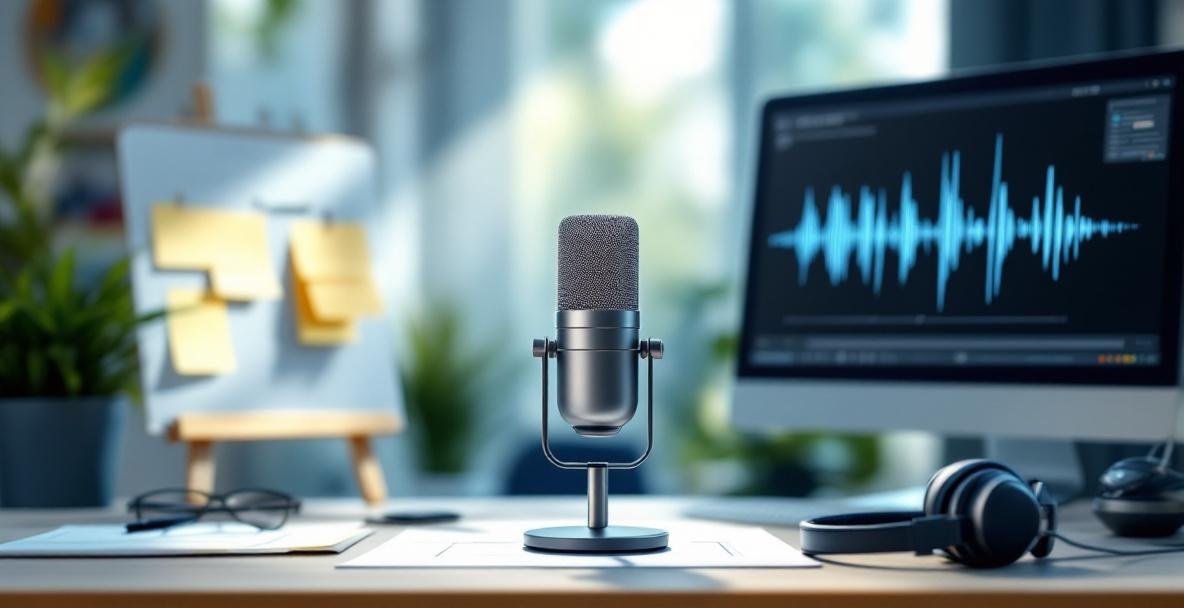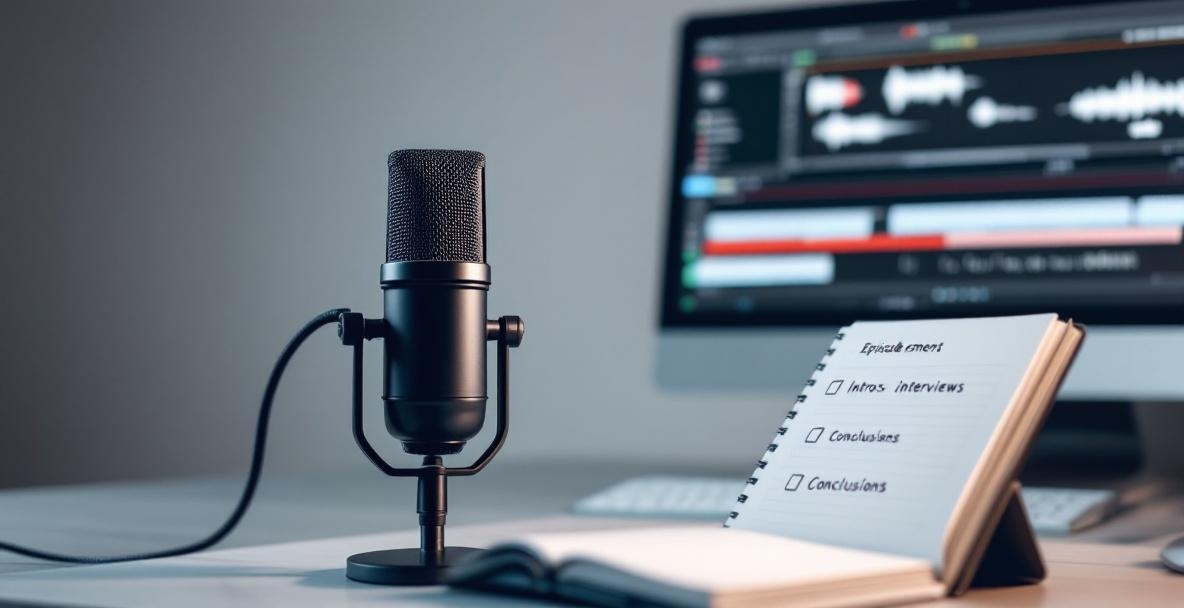Ever tuned in to a podcast that instantly pulls you in and keeps you listening, while another one leaves you checking your watch after a few minutes? It isn’t just about clever ideas-it’s about how you set things up. When your episode has a solid structure and a clear flow, your listeners feel like they’re on a real journey with you. At Castee, we know that planning every detail can make all the difference when you want to connect with your audience.
Why a Thought-Out Setup Makes a Difference

Structure works like the hidden backbone of your show. Just like a well-built house needs a strong foundation and careful design, your podcast needs a clear plan if you want your message to hit home. Even the coolest ideas and most engaging hosts can lose their punch without proper organization.
How you arrange your episode matters for everything-from keeping your listeners hooked to growing your audience and even boosting your earnings. A neat, intentional layout makes your work easier to manage, too, smoothing out recording sessions and making editing a breeze.
When you have a good plan, you can stick to a regular posting schedule, which is essential for building a loyal following that looks forward to every episode.
Grab Them Fast: Nailing That Opening Hook
The first 30 seconds are your chance to win people over. In that short window, listeners decide if they want more or if it’s time to skip out. A strong hook should spark curiosity and set the mood right away.
It’s key to let your audience know early on what they are in for. Will they learn a game-changing tip, hear a funny story, or pick up wisdom from an expert? Make sure you highlight what’s in it for them from the very start. A great opening mixes promise with a little mystery so people can’t help but stay tuned.
You might kick things off with a thought-provoking question, a surprising statistic, or a compelling anecdote that fits your topic. If you’re doing an interview, teasing an interesting quote from your guest or hinting at an unexpected insight can work wonders.
When Format Fails: The Pitfalls of a Messy Show
A podcast with a jumble of ideas leaves listeners feeling lost. When your talk seems to jump from one thought to another without a clear plan, people can quickly become confused, which may lead them to skip your episode or even unsubscribe. A messy format really kills the vibe.
Not only does poor organization frustrate your audience, it also makes it hard to share your best bits on social media or through newsletters. Without clear breaks and smooth links between ideas, turning an episode into bite-sized content can become more trouble than it’s worth, limiting your overall reach.
From a technical standpoint, if your episode feels unstructured, search engines and podcast platforms might have a tougher time recommending it to new listeners. A clear, logical format helps these systems understand your content, which means more people can discover your show.
Breaking Down the Podcast Episode

Every memorable podcast is built from parts that work well together. When you break down an episode, you see it follows a natural path that keeps listeners engaged. Knowing these building blocks lets you mix things up creatively while still keeping the flow smooth.
Think of your episode like a story with a clear beginning, middle, and end. Each part adds to the overall experience, creating a river of ideas that leads your listeners along. With a strong framework in place, you have the freedom to explore new ideas without losing your audience.
Kicking Off Right: Setting Up Your Episode
The very start of your show is much more than a quick hook. Those first few minutes set the tone and let your listeners know what to expect. A warm welcome paired with a sneak peek into the topic can make everyone feel at home.
Your introduction should remind people why they tuned in and why your podcast is worth their time. You might say something like, "Welcome to [Podcast Name], where we turn creative ideas into lively conversations. Today, we’re diving into tips that can grow your listener base and brighten your storytelling."
This opening moment is also when you set the mood. Whether you want the chat to feel relaxed, upbeat, or thoughtful, keep the tone in line with your overall style while matching the topic. Consistency here gives your regular fans that cozy feeling, while a touch of variation keeps it from ever feeling stale.
The Heart of Your Podcast: Bringing Real Value
This is where you deliver on the promise made in your opening. The main part of your episode should have a clear flow, with each idea building on the previous one. A well-planned body of content keeps listeners engaged as you explore your topic from different angles.
Mix things up between telling a story, explaining a concept, and sharing examples to keep the energy high. For interview shows, gently steer the conversation so that each segment links smoothly to the next, giving your discussion a natural and lively feel.
Smooth transitions are key. Little phrases like "Now that we’ve covered that part, let’s see how this connects" work like signposts. They help your listeners follow your conversation without missing a beat.
Finishing Strong: Making Your Episode Memorable
Wrapping up isn’t just about ending the chat; it’s your chance to leave a lasting mark. A thoughtful conclusion sums up the key points and helps your listeners remember the best insights. A good recap should hit on the most important takeaways without rehashing every detail.
Your finale should also include a clear call to action. Whether you’re urging listeners to try out a tip, explore a resource, or connect on social media, be specific about the next step so people know exactly what to do.
Finally, hint at upcoming episodes to build excitement. You might say, "Next week, we’re chatting with [Guest Name] about trends that could reshape your work." This kind of tease leaves listeners eager for more and helps keep your audience coming back.
Building a Reliable Podcast Format

Sticking with a regular format can make a big difference for both you and your listeners. When people know the drill, it makes your episodes easier to follow and gives your show a professional vibe. It also helps you stay on track behind the scenes, which means less stress during recording and editing.
Your show’s blueprint should fit the kind of content you create and what your audience loves. Whether you focus on troubleshooting common issues, sharing personal experiences, or hosting expert interviews, the structure should feel natural to you. Finding that sweet balance between a set plan and room for personality is what makes your podcast stand out.
Sticking to the Plan: Why Consistency Helps
Having a regular structure builds trust. When your listeners know what to expect, they can easily fit your podcast into their routine. That reliable feel is what turns a casual listener into a fan over time.
Think of your podcast as a friendly space where people always know they’ll get a dose of engaging experience. When your format is steady, it makes the whole listening experience smoother and more enjoyable. That regularity transforms your show into a familiar retreat for your audience.
Making Your Format Truly Yours
Even with a set plan, it’s important that your structure reflects who you are as a podcaster. Your chosen layout says a lot about your style-whether you’re all about neat, precise segments or a laid-back, chatty flow.
Consider how every part of your episode fits into your overall vision. Maybe you have a special segment for practical tips or a signature way to open each show. Tailoring your format to fit your brand turns routine into something memorable.
Also, think about the length and frequency of your episodes. Short, regular episodes might call for a simpler format, while longer shows can afford to explore more varied segments. The goal is a format that feels manageable for you and exciting for your listeners.
Smart Ways to Plan Your Episodes

Good planning can turn scattered ideas into a well-organized show. By taking the time to map out your thoughts, you can connect topics, fill in any gaps, and avoid repeating yourself. This kind of planning helps your episodes flow naturally from start to finish.
There are plenty of tools available, whether you prefer dedicated podcast software or a simple document, to help streamline your planning process. Experiment with different methods until you find a system that feels right for you and lets your creativity shine.
Scripted, Free-Form, or a Bit of Both?
Every podcaster has their own style somewhere between following a full script and just chatting off the cuff. Some shows work best when every word is planned, while others benefit from a relaxed, spontaneous style. The trick is finding that balance where you have enough structure to keep things on track without killing your natural flair.
Using a full script gives you tight control over your message and timing, which is perfect for detailed stories or technical topics. But it can sometimes come off a bit stiff. On the flip side, free-form conversations feel raw and genuine but can stray if you’re not careful to steer them back on track.
Many find that a middle-ground works best. Try creating a detailed outline of your main points while leaving space for those genuine insights that happen in the moment. This way, you keep the conversation focused and natural at the same time.
Outlines and Storyboards: Your Episode Roadmap
Think of an outline as the roadmap that keeps your episode moving in the right direction. A solid outline covers your opening hook, key discussion points, smooth transitions, and a strong finish. With a clear roadmap, you’ll never miss a crucial topic during recording.
For episodes with lots of twists and turns, storyboarding can help too. Write down not only your talking points but also ideas for tone changes, sound effects, or moments when you want to shift gears. This method is especially handy for narrative shows or episodes with multiple guests.
Digital tools like Trello or Notion can really simplify this process. Even a shared document can do the job when you use it consistently, ensuring that every episode stays on track and feels cohesive.
Keeping It Flexible: Adapting Your Structure on the Fly
A flexible plan is key to handling those unexpected turns during a conversation. Think of it as having checkpoints along your journey so you always know where you are, even if the discussion winds off course. This balance helps keep your show both lively and organized.
One practical trick is to jot down a few "topic cards" for each major idea. These little notes let you rearrange the order or spend extra time on a subject if the conversation takes an interesting twist. It’s a simple way to cover everything without feeling boxed in by a plan.
Another idea is to schedule short pauses during your recording. These breaks give you time to check in with your outline and adjust if needed, ensuring that even if you wander a bit, you can smoothly steer the conversation back on track.
When It’s Okay to Break the Rules
Some of the most memorable moments on a podcast come when you stray from the script. A well-timed tangent can lead to surprising insights and real connections with your listeners. The trick is knowing when a detour adds value and when it just distracts.
Learn to recognize the difference between a helpful sidestep and a long, off-topic monologue. Those unexpected moments can create authentic connections with your audience, but too many can throw your episode off balance.
If you do decide to veer off track, offer a quick explanation. Saying something like, "This wasn’t planned but is too interesting to ignore," helps your listeners follow along. Then, make sure to guide the conversation back to your main storyline.
Final Thoughts: Nailing Your Podcast Structure
Putting together a well-organized podcast episode isn’t about cramping your creativity. It’s about giving your ideas a clear path so they can hit home and stick with your listeners. A smart structure supports your message, keeps your audience engaged, and makes the whole production process smoother.
Remember that finding the right formula takes time. Listen to feedback, keep an eye on how long people are listening, and don’t be afraid to tweak your style. Every episode is a chance to fine-tune your approach and make your podcast even better.
Ready to take your podcast structure to the next level? Visit Castee today to access our comprehensive suite of podcast marketing tools designed to amplify your carefully structured content. Our platform helps you leverage your well-organized episodes for maximum visibility, engagement, and growth. From SEO optimization to audience analytics, we provide everything you need to ensure your thoughtfully structured podcast reaches the audience it deserves.
Leave a Reply